Easy Fall Clean Up: How To Do It Fast This Year
I remember how excited I was, as a kid, to watch the autumn leaves float off the trees and weave a colorful blanket on the ground.
My mom would rake them up into huge piles on our lawn. And I couldn’t wait to bundle up, run outside, and dive right into that tall, crispy pile!
Now, as an adult, the leaves are still just as beautiful, but I’m the one doing the raking! So, it’s not quite as fun…
Since fall cleanup means the gardening season is ending, it isn’t my favorite gardening task. I’d rather be enjoying my garden by starting seeds, planting, and yes, even weeding!
So, I’ve developed some strategies that make fall clean-up easier and faster. And they’ll work for you too!
A big bonus is that doing this fall clean-up will save you time and energy next year during the spring gardening rush.
Here are my top strategies and time-saving tips for fall cleanup.
Heads up: I’ll earn a small commission if you buy something after clicking a link in this post. I only link to products I’d recommend to my best friend.
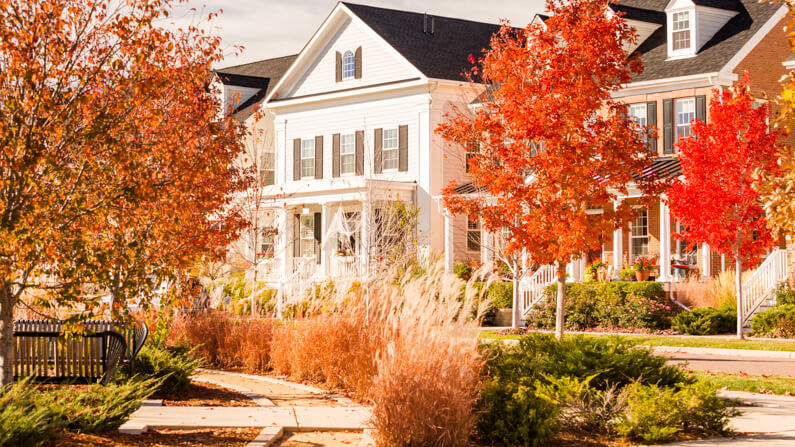
Fall clean up in your vegetable garden.
When you’ve had your first hard frost, that’s the time to clean up any warm-season vegetables like peppers, tomatoes, and eggplant.
Vegetable garden “sanitation” clean-up is super important in the fall.
- Vegetables are susceptible to a lot of disease issues, and leaving plants up in your garden can result in more disease problems next season.
- So, don’t leave any plants in your garden that had a disease or significant insects this season.
- To be on the safe side, don’t put any heavily diseased plants in your compost pile. Most home compost piles don’t get hot enough to kill diseases, so put these plants in the trash.
- The only plants you should leave in your vegetable garden are winter cover crops and any fall and winter vegetables you’re currently growing.
- This is also the time to make a last sweep for weeds, and remove any temporary structures like pea trellises or garden stakes.
Related freebie: FREE landscape maintenance checklist
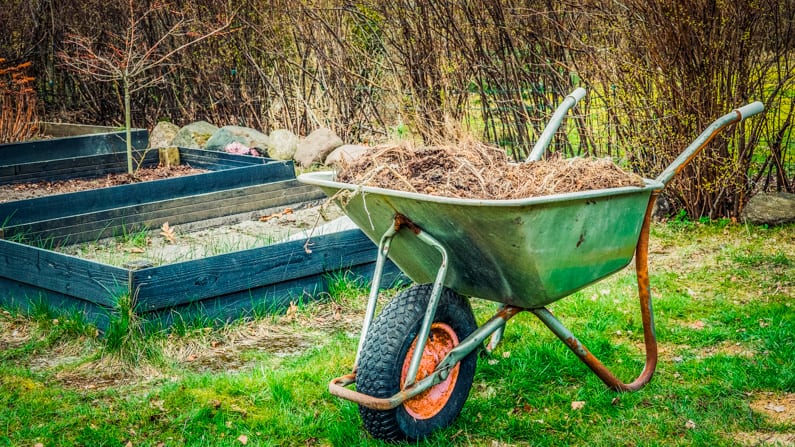
Time-saving tips:
- Clean and sharpen your hand pruners before starting. The sharper your cutting blades, the easier it is to cut, cut, cut! This is my favorite pair of hand pruners.
- Use a large collapsible bin, like this one, to collect large amounts of plant matter from your vegetable garden. It means fewer trips to your compost pile, garbage can, or truck or trailer – if you’re going to haul everything away.
- After you clean up your vegetable beds, consider adding a layer of compost or manure to your beds. It’ll save you time next spring. (And fall is the only time you should add fresh manure to your vegetable garden due to possible diseases like E. coli).
- After you spread your compost or manure, add a layer of straw mulch to your vegetable beds for the winter, unless you have problems with voles or mice.
My Favorite Fall Clean-Up Tools
Prices last updated on 2025-07-10 at 08:35
Cleaning up perennials in the fall.
At the end of the summer, most perennials start to look a bit ragged, and by the time you’ve had your first frost, it’s time to start cutting back your perennials.
By removing the foliage, you’re getting insects and disease out of your garden and giving yourself room to rake up leaves.
And next spring, when your perennials come back, the new growth won’t have to compete with this year’s growth for space and sunlight.
But not all perennials need to be cut back now.
So how do you know what to trim and what to leave up? Let’s start with what you may want to leave up.
Don’t cut back:
- Plants that add winter interest to your garden. Any plants that have interesting seed heads or look good poking out of the snow can be left up, unless you need to remove them for another reason See the “do cut back” list below.
- Plants that feed wild birds like coneflowers, joe-pye weed, and asters can be left up as a food source for the winter. For a full list of plants that feed wild birds, check out Backyard Bird Secrets for Every Season. It’s a fantastic guide to enjoying backyard birds all year long!
Poor indeed is the garden in which birds find no homes. – Abram L. Urban
- Perennials that benefit from not being cut back like some daylilies, Oriental poppies, and any plants that remain evergreen through the winter. How do you know if a particular plant will stay evergreen? A good rule to follow is if they’re brown and withered by late autumn, cut them back. If they’re green and look healthy, don’t cut them back.
- Woody subshrubs like Russian sage, butterfly bush, and lavender shouldn’t be cut back until spring when you can see how much of the plant was killed off over the winter.
- Most ornamental grasses should be left up so you and your bird friends can enjoy their beautiful seed heads all winter long. But some grasses break down or lose their color over winter. These are best cut down in the fall. Learn how and when to prune your ornamental grasses.
Do cut back:
- Any diseased plants, and any plants that are prone to disease or pest problems. For a full list of disease and pest-prone plants, check out The Well Tended Perennial Garden. It’s on my list of the best gardening books for beginners.
- If you have problems with voles, cut back as much low-growing foliage as you can to prevent them from having good “cover” over the winter. Cut back any plants that tend to mat like irises, or create dense cover like coreopsis. Removing the voles’ winter cover will discourage them from making a home in your garden, and will make them easier to trap.
- Any seedheads on your “weedier” plants – the ones that volunteer like crazy, make a nuisance of themselves, pop up everywhere and create more weeding chores in the spring. You can leave the foliage of these plants up to provide places for butterflies and beneficial insects to shelter over the winter.
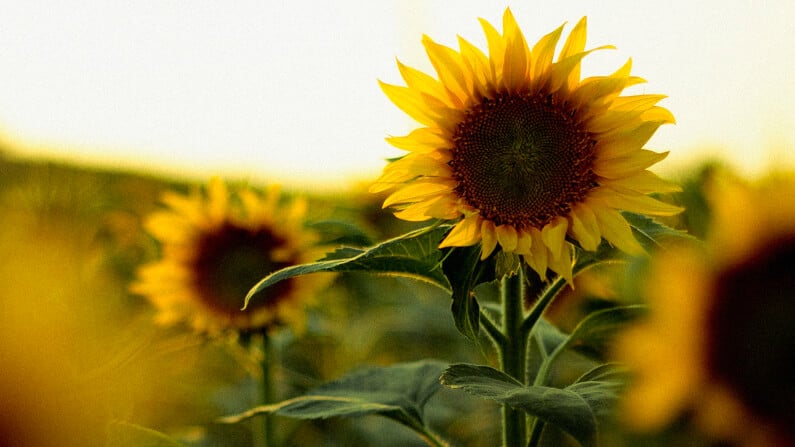
Time-saving tips:
- Work your way through your garden a section at a time. Once you see how good the first section looks, you’ll be motivated to keep going.
- Clean and sharpen your hand pruners before starting. The sharper your cutting blades, the easier it is to cut, cut, cut! This is my favorite pair of hand pruners.
- Use multiple collapsible bins, like this one, to collect large amounts of plant matter from your perennial garden. It means fewer trips to your compost pile, garbage can, or truck or trailer – if you’re going to haul everything away.I use for a large one for plant trimmings that can be composted, a small one for seedheads I want to spread around the garden, and another large one for anything that needs to go in the trash.
- I also find that listening to music, audiobooks, or podcasts helps me work faster, and I take fewer breaks. As I said, this isn’t my favorite task.😉
- Rake the leaves from your beds after you cut everything back. It’s much easier to rake when you have more room to maneuver. And you’ll be able to rake up any stray plant leaves and stems.
- You don’t have to get every last leaf out of your beds. In fact, leaving some leaves creates homes where beneficial insects can overwinter.
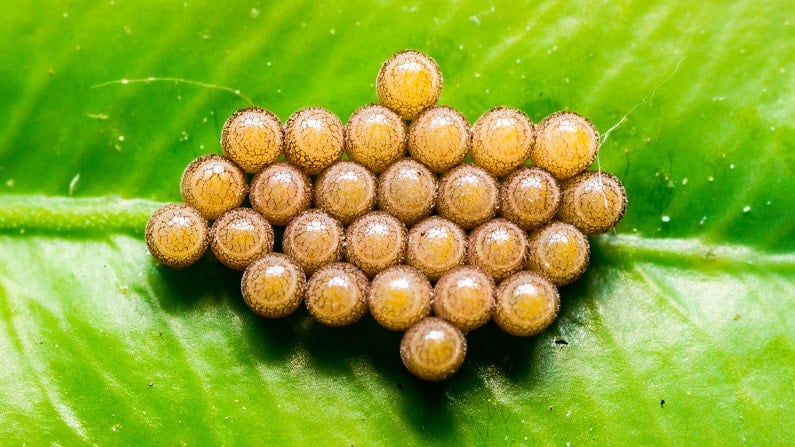
Time-Saving Fall Clean-Up Tools
Prices last updated on 2025-07-10 at 08:35
Mulch your perennial beds
After you’ve cleaned up your perennial beds, re-mulch any areas that are getting thin. Using an organic garden mulch on your perennial beds is the number one way to improve your soil and keep your perennials healthy.
Leaf clean up tips.
Start raking leaves the first day they fall.
If you stay on top of this chore, it will be manageable.
It’s ok to leave some leaf litter in your flower beds, as long as the leaves aren’t so thick that they create a mat. When they mat and get wet, they can kill herbaceous perennial plants.
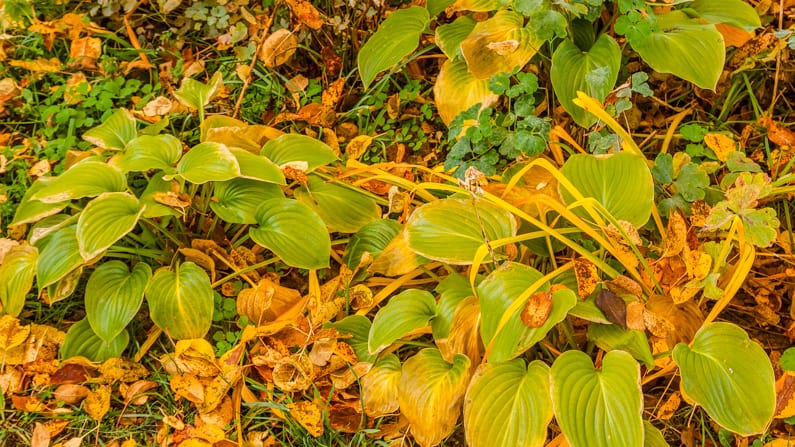
Many butterflies and beneficial insects lay their eggs on leaves and use them as winter protection. So, don’t feel that you need to remove every leaf from your garden when you’re doing your clean-up.
If you have a bed or two that are planted with plants native to your area, and they do just fine with a layer of leaves covering the ground over the winter, then this could be the perfect place to just let the leaves be.
- If the leaves won’t blow around too much during the winter and make a mess you’ll have to clean up later, then go for it!
- You’ll be helping butterflies and other insects.
Related: The 9 Best Lawn Care Books: Start Growing Great Grass Now
How to clean up fall leaves in less time.
Even if you’ve been raking leaves since you were a kid, there are a few tips and tools you might not know about that’ll make this chore easier and make yard clean up a snap.
Tired of stopping every five minutes to unclog your rake? Try a “no clog” rake. The tines don’t skewer the leaves, so you don’t have to keep stopping to unclog it. There are several brands to choose from.
- 30-Inch poly head
- Patented tine design eliminates clogging
Prices last updated on 2025-07-10 at 08:35
Have large lawn areas to rake, but don’t want to spend all day raking? The bigger the rake, the faster the raking! A big rake makes raking leaves a quicker task. Be sure to choose a rake that’s at least 30” wide if you have large areas to rake.
- 30-Inch poly head
- Large head for maximum raking capacity
Prices last updated on 2025-07-10 at 08:35
Need to rake leaves out of tight spots like flower beds and in between shrubs? An adjustable rake allows you to get into spaces a regular rake can’t go.
- ✅ 63 Inches Long. Similar rakes on Amazon are only 48 inches long. The adjustable head expands From 7...
- ✅ 15 Flat Tine Expandable Head. Adjust the rake width to a tiny 7 inchs for tight areas. This rake is...
Prices last updated on 2025-07-10 at 08:35
For even faster clean up, see my recommendations below for mulching leaves that land in flower beds.
Once you have your leaves raked up, what should you do with them?
Mulch your leaves
Mulching, or grinding up your leaves, turns them into smaller pieces that you can turn into compost or leaf mold. Or you can use them as natural, organic mulch.
And there are a few different ways to mulch your leaves.
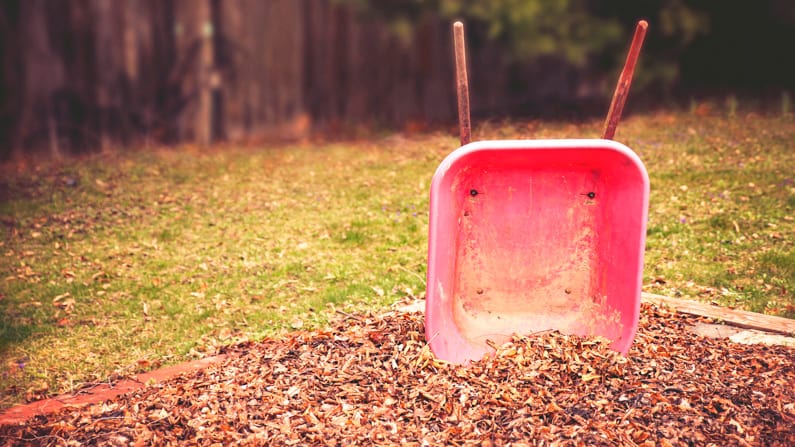
Want to mulch the leaves that end up in your flower beds or borders?
Use a leaf vac with an attached bag. A leaf vac sucks up leaves fast, especially in and around flower beds. I only have to empty mine every 20 minutes or so when I’m vacuuming up leaves.
You also can rake the leaves off your beds and onto your lawn, and then follow these tips for mulching the leaves on your lawn. Just be sure you don’t damage any of your plants with your rake tines.
Need to mulch the leaves on your lawn?
There are a few different ways to get this task done quickly.
- Use your leaf vacto suck up the leaves and turn them into leaf mulch.
- Use your mulching mower, with the bag attached, to mulch and bag the leaves.
- After raking the leaves, put them through a leaf mulcher.
My Favorite Mulching Tools
Prices last updated on 2025-07-10 at 08:35
Don’t have a way to mulch your leaves, but still want to compost them? You can create leaf mold out of your leaves.
Fall Clean Up: Your Turn
Now that you know how to make fall clean up easier and faster, you might even have enough time left over to jump into a tall pile of crispy leaves this fall!
How do you clean up your fall garden? Share in a comment below!














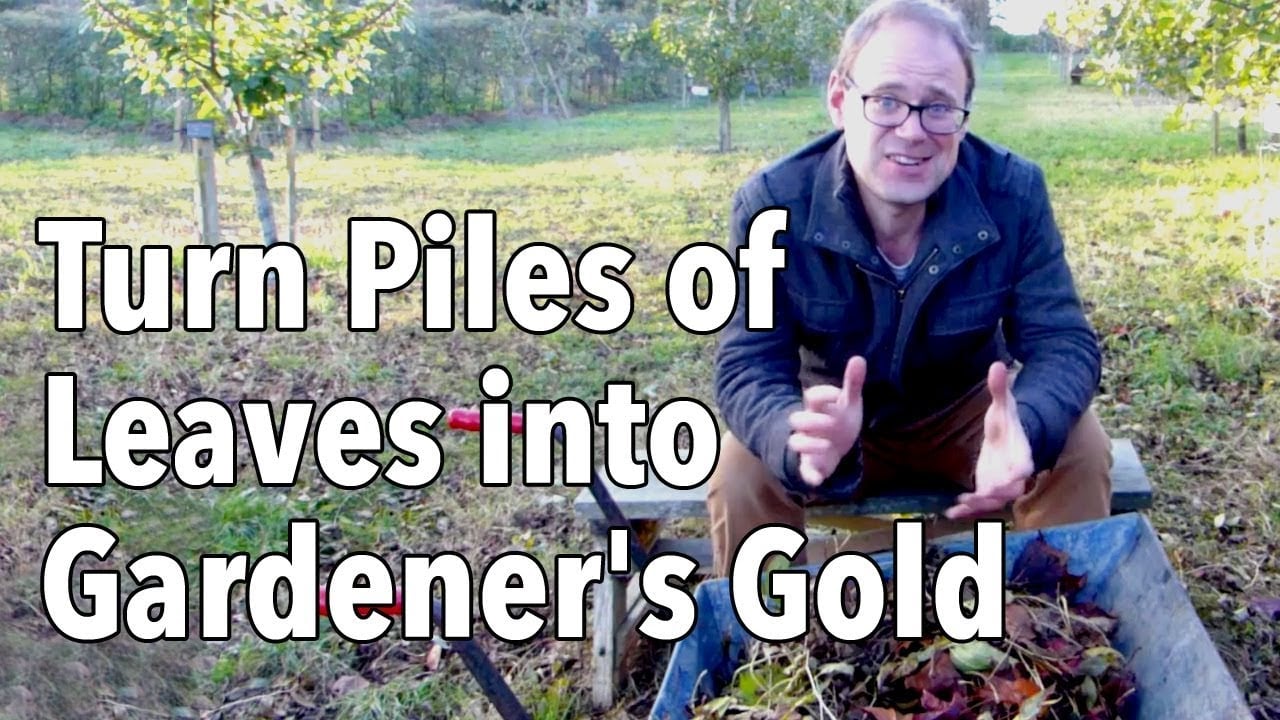
Can you tell me about winterizing Iris beds? Should I leave the Crabapple and Saskatoon leaves in the bed, because I don’t have any mulch? Or should I clean out all those leaves and just have bare ground?